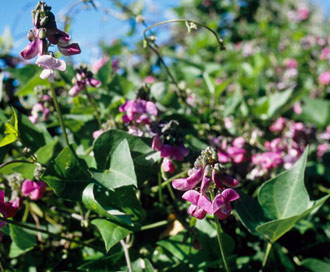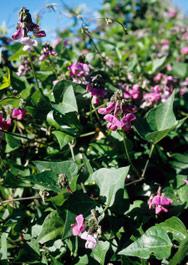Dipogon lignosus
Dipogon lignosus (L.) Verdc.
Family: Fabaceae
Common names: Cape sweet pea (Eng.), mile-a-minute vine, dolichos pea (Australia); bosklimop, rankertjie, wilde-ertjie (Afr.) (= Dolichos lignosus L. and D. gibbosus Thunb.)
Introduction
The Cape sweet pea "is a delicate and beautiful twiner and well worth cultivating" (Pole Evans 1931). This plant is a semi-evergreen, hardy perennial with fragrant eye-catching flowers and minimal watering needs, making it a worthy garden subject, but it should be cultivated with care as it is known to be invasive in some areas.

Description
Description
Dipogon lignosus is an herbaceous perennial with a climbing habit, becoming woody below. Its green softwood stems climb up nearby structures, shrubs or trees, sometimes growing more than 2 m tall and extending far sideways when given the chance. The leaves are pinnately trifoliolate (composed of three leaflets) and are a dark to medium green with a light underside. The leaflets are diamond-shaped, with a wide set base and and then tapering to a fine point. Each leaflet has its own stipule.
Pink, mauve, magenta and purple peaflowers adorn the new growth on stemtips in short, dense racemes on long peduncles. Flowers occur throughout spring and summer (August to January). The fruits are flat, sickle-shaped pods, containing four to six seeds each, and form shortly after flowering. This fast growing twiner is evergreen in warmer climates, but may become deciduous in areas where frost occurs.

Conservation Status
Status
Dipogon lignosus is Least Concern in the Red List of South African plants (Raimondo et al. 2009), meaning that it is not threatened. In Australia and New Zealand this plant has become a highly invasive weed, climbing into and smothering trees and shrubs, as well as spreading sideways and covering large areas of ground and ground cover plants.
Distribution and habitat
Distribution description
Dipogon lignosus can be found growing naturally throughout the Western Cape and Eastern Cape, usually along forest margins and stream banks, scrambling over other shrubs and trees. It prefers the milder climate zones, where frost is minimal.
Derivation of name and historical aspects
History
The Latin word lignosus means woody, and refers to the woodiness of the stems at the base of the plant. Dipogon is from the Greek di, meaning two, and pogon, a beard, referring to the style which is thickly bearded on the upper side near the tip.
Dipogon previously belonged in the genus Dolichos. Bernard Verdcourt (of the Royal Botanic Gardens, Kew) studied the genus in the 1960s-70s. When he started, it consisted of about 120 species spread throughout the world. He organised the Dolichos complex into distinct units and gave a new description for Dolichos, which now consists of about 60 species confined mainly to Africa but extending to India and East Asia, with about 12 in southern Africa. The name is derived from the Greek dolichos, meaning long, as in long in time or wearisome, probably referring to the long shoots.
The genus Dipogon was re-instated by Verdcourt in 1968 because it was already established as a synonym for Dolichos lignosus. Dolichos was originally named and described by Linnaeus in 1753. Liebmann described Dipogon in 1854. Dipogon is a genus of a single species found only in South Africa, although it has been widely cultivated since the early nineteenth century in Europe, Madeira, Azores, Sri Lanka (Ceylon), Australia, California, Brazil, Chile and Uruguay.
Ecology
Ecology
Once ripe, the seed is explosively flung out of the pod, falling far from the parent plant. These seeds can remain dormant for a number of years in unfavourable conditions, only germinating once a disturbance of sort occurs (e.g. fire, rain and seasonal changes). Being a leguminous plant, Dipogon lignosus naturally enriches the soil, due to nitrogen-fixing bacteria living in its root nodules. The plant supplies the bacteria with food and refuge and the bacteria supply the plant with usable nitrogen gathered from soil minerals.
Uses
Use
Dipogon lignosus is used in horticulture as a decorative climber. It survives more than one growing season, but some gardeners use it as an annual rather than a perennial. It is also planted as a natural soil enricher, as most legumes give home to nitrogen-fixing bacteria in their roots nodules. Young pods can be eaten as a vegetable.

Growing Dipogon lignosus
Grow
This plant thrives when placed in a sunny position and in a well-drained soil. The recommended soil is a balanced mix of bark, sand, compost and the average garden loam. The plant will tolerate dappled shade and poor soil. A good watering in the heat of summer is always appreciated, otherwise let the seasonal rains do the work. Dipogon is fast-growing and needs to be pruned every season to keep it tame. It is best kept in check by cutting it back completely in winter, once the plant has shed its flowers. To prolong the flowering period, one can pick off dead flowers, which prevents the plant from spending energy on the production of seeds.
The plant is best propagated from seed. Before harvesting seed, wait for the seed pods to dry. This usually happens at the start of autumn. Pick the pods off the plant before they naturally crack open and disperse the seed. It is always best to sow the seed as soon as possible after harvesting. Sow seed in autumn. Place the seed in a well-draining seedling mix (finely sifted bark works well or buy a seedling mix at a local garden centre) or even sow straight into the garden, being careful to water the patch regularly. When sowing seed in the garden, take care to compost and wet the soil first. Germination takes place between 10 and 14 days after sowing. The seedlings need some protection from direct sunlight during the first week or two of growth. Flowering takes place 3 to 4 months after germination.
The Cape Sweet Pea looks best when grown along a fence or over a trellis or even in hanging-baskets. Its soft green stems need support. It needs to be kept in check in order to prevent it from smothering neighbouring plants. Dipogon lignosus also looks good planted with companion plants such as Pelargonium spp., Polygala spp., and other members of the Fabaceae family such as Psoralea spp.and Podalyria spp. and even as part of a woodland garden.
Pests affecting Dipogon lignosus include snails and slugs and a variety if insects (e.g. pollen beetles and aphids). One can try an eco-friendly pesticide to reduce pest numbers or encourage the creatures that eat these pests (e.g. ladybirds, spiders and ducks) to make one's garden their home. Take care where this plant is grown, as it could become a pest if grown in the wrong place and allowed to invade neighbouring or nearby natural areas.
References
- Anon. 1980. Wild flowers of South Africa. Struik, Cape Town.
- Bohnen, P. 1995. More flowering plants of South Africa. The Still Bay Conservation Trust, Still Bay.
- Eliovson, S. 1960. South African wild flowers for the garden. Howard Timmins, Cape Town.
- Jackson, W.P.U. 1990. Origins and meanings of names of South African plant genera. University of Cape Town Printing Dept., Cape Town.
- Leistner, O.A. (ed.). 2000. Seed plants of southern Africa: families and genera. Strelitzia 10. National Botanical Institute, Pretoria.
- Manning, J. 2003. Photographic guide to the wildflowers of South Africa. Briza Publications, Pretoria.
- Manning, J. 2007. Field guide to Fynbos. Struik Publishers, Cape Town.
- Mathews, J.W. Cultivation of non-succulent South African plants. Specialty Press of South Africa, Cape Town.
- Moriarty, A. 1997. Outeniqua to Tsitsikama and the Eastern Little Karoo. Botanical Society of South Africa, Cape Town.
- Pole Evans, I.B. 1931. Flowering Plants of Africa 11. L.Reeve & Co. L.T.D., Cape Town.
- Raimondo, D., Von Staden, L., Victor, J.E., Helme, N.A., Turner, R.C., Kamundi, D.A. & Manyama, P.A. (eds) 2009. Red List of South African plants 2009. Strelitzia 25. South African National Biodiversity Institute, Pretoria.
- Smith, C.A. 1966. Common names of South African plants. Memoirs of the Botanical Survey of South Africa No. 35.
- Step, E. Favourite flowers of garden and green house, vol.1. Frederick Warne & Co., London.
- Vanderplank, H.J. 1999. Wild flowers of the Port Elizabeth area: Gamtoos to Swartkops rivers. Bluecliff.
- Van der Spuy, U. 1976. Gardening with climbers. Protea Press Publishers, Stellenbosch.
- Van der Burgt, X.M., Van Medenbach de Rooy, J. M. 1994. The biodiversity of African plants: proceedings, Xivth AETFAT Congress. Kluwer Academic Publishers, The Netherlands.
- Verdcourt, B. 1968.Notes on Dipogon and Psophocarpus (Leguminosae). Taxon 17,5,Oct. 1968.
Credits
Rebecca Wengrowe & Alice Notten
Kirstenbosch National Botanical Garden
February 2012
Plant Attributes:
Plant Type: Climber, Ground Cover, Perennial
SA Distribution: Eastern Cape, Gauteng, KwaZulu-Natal, Mpumalanga, Northern Cape, Western Cape
Soil type: Sandy, Loam
Flowering season: Spring, Early Summer, Sporadic/All year
PH: Acid, Neutral
Flower colour: Purple, Pink, Mauve/Lilac
Aspect: Full Sun, Morning Sun (Semi Shade), Afternoon Sun (Semi Shade)
Gardening skill: Easy
Special Features:
Horticultural zones











Rate this article
Article well written and informative
Rate this plant
Is this an interesting plant?
Login to add your Comment
Back to topNot registered yet? Click here to register.